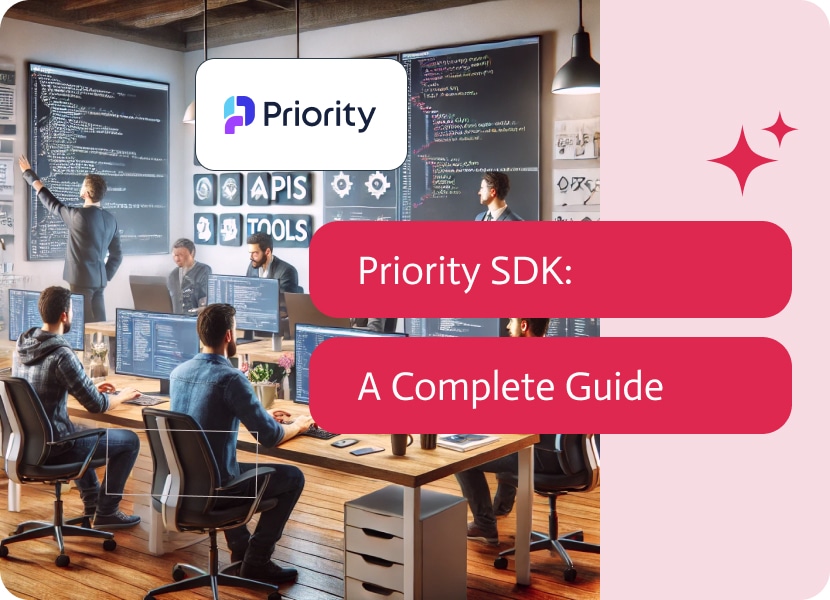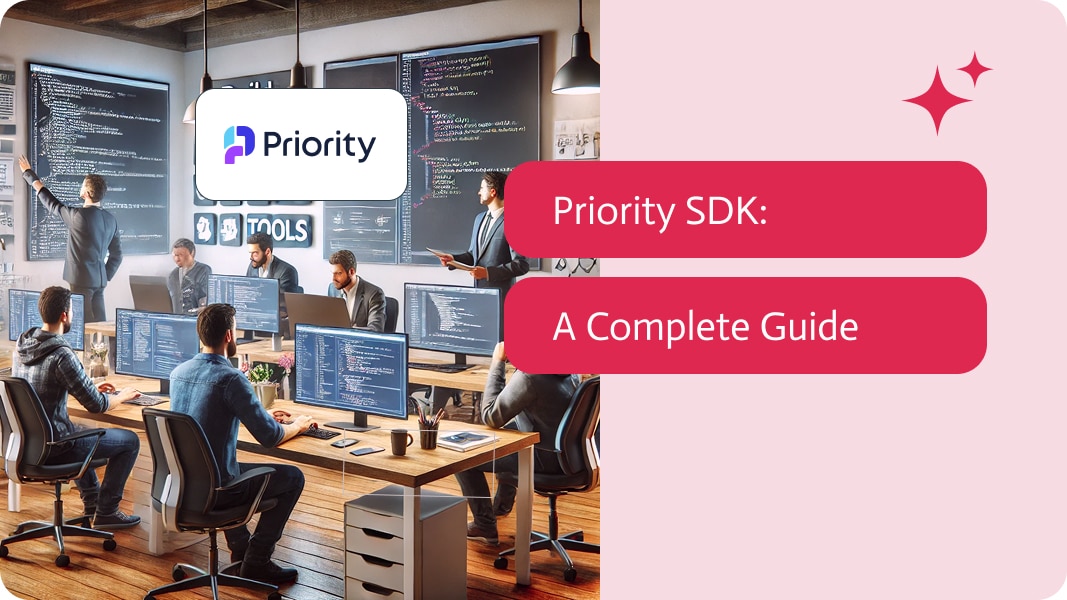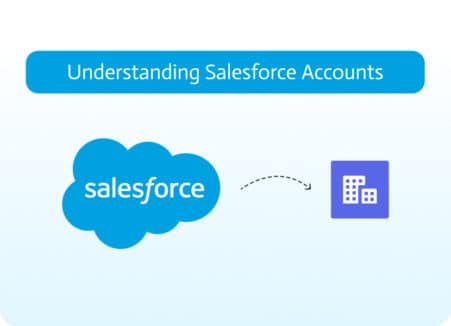

Priority SDK: A Complete Guide
For developers working in the ERP space, the Priority SDK is a powerful tool for customizing and automating workflows. The SDK makes it possible to adapt Priority ERP for specific business needs, allowing integration, data management, and reporting solutions that make work easier and more efficient. Combined with an iPaaS solution like Noca AI, the SDK becomes even more valuable, creating smooth data flows across platforms while leveraging advanced AI. This guide covers how to get the most out of the Priority Web SDK, offering practical insights to maximize the SDK’s impact.
1. What is the Priority SDK?
The Priority SDK (Software Development Kit) is a development toolkit that allows for in-depth customization of Priority ERP. Its tools empower developers to:
- Construct and modify database structures.
- Build and automate customized forms.
- Apply SQL syntax with Priority-specific functions.
- Generate tailored reports and workflows.
Using the SDK makes it easy to align ERP processes with unique business needs and to create features that simplify data handling. Priority’s flexibility allows it to meet industry-specific requirements, providing functionality that goes beyond default ERP settings. When the SDK is combined with an iPaaS, developers can automate data updates across other systems for improved data accuracy and consistency.
2. Core Features of the Priority SDK
Let’s look at the Priority SDK’s main capabilities and how each can be applied in real-world development.
Database Customization
One of the Priority SDK’s primary capabilities is database customization. With the SDK, developers can:
- Define Custom Tables and Columns: This allows developers to adapt the ERP data structure to meet specific needs.
- Set Unique Keys and Indexes: Keys and indexes speed up data retrieval, making applications responsive and efficient.
- Use SQL with Extended Priority Functions: Priority SQL syntax includes Priority-specific commands and operators, making data queries highly flexible.
To ensure efficient development, the Priority SDK encourages clear naming conventions, especially when working with larger, enterprise-level data systems.
Form Design and Triggers
Form customization through the Priority SDK is another key strength. The SDK provides developers with the tools to create new forms, add form attributes, and set up triggers that activate on specific actions, such as data updates.
- Custom Forms: Developers can design forms to streamline data entry and add custom fields as needed.
- Triggers: Triggers allow for real-time validation and manipulation of data as users enter information. They can also automate actions like sending notifications when form updates occur.
For example, with the Priority Web SDK, you could build a form that manages customer orders and automatically updates order status fields based on custom triggers.
Reports and Automated Procedures
The Priority SDK enables customization of reports and automation of repetitive tasks. It’s possible to build detailed reports and automate workflows based on various business needs, enhancing efficiency and enabling data-driven decisions.
- BI Reports: Customizable BI reports provide insights into real-time data, supporting better decisions based on current business conditions.
- Automated Procedures: By using the Priority SDK, developers can automate ERP tasks like generating a sales summary each week or notifying staff when new orders arrive.
These automation capabilities are extended with the Web SDK for web-based interactions, where automation can be directly triggered by user actions or events within the ERP.
3. Best Practices for Priority SDK Development
Developers can take several actions to ensure efficient and consistent results with the SDK.
Coding Standards and Naming Conventions
When using the SDK, establish clear naming conventions and keep code well-organized. This not only simplifies troubleshooting but also aids team collaboration, especially when several developers work on the same project.
Testing and Debugging
The SDK includes a suite of debugging tools that help identify issues in custom forms, triggers, and database modifications. Testing each customization is crucial to avoid errors in data processing, especially for ERP functions that impact various business processes.
Version Control and Documentation
Documenting every customization is essential. Proper version tracking prevents confusion in collaborative environments and allows you to revert changes if necessary.
4. Using Priority SDK with an iPaaS Solution
Combining the SDK with an iPaaS unlocks extended functionality and simplified cross-platform data flows. The SDK manages customization within Priority, while the iPaaS handles integrations with other systems, enabling seamless data synchronization.
For example, a company using the Priority Web SDK can automate customer data updates across all platforms by connecting Priority ERP with an iPaaS solution. This integration keeps data current across all applications, removing data silos and reducing manual data entry.
Example Use Case: A customer service company uses the Priority SDK to set up custom fields and triggers for tracking client interactions. By connecting these features with an iPaaS, they can also sync customer details with a CRM, making the process seamless and AI-driven for efficiency and data accuracy.
5. Real-World Example: Automating Customer Data Updates
Here’s a step-by-step example to showcase the power of the Priority SDK for data automation.
- Create Custom Fields: Use the Priority SDK to add custom fields to the customer table for essential data, such as communication preferences.
- Build Data Entry Forms: Create forms with the Priority Web SDK that use these custom fields for easy data input.
- Write Data Update Triggers: Set up triggers within the SDK to automatically update specific fields when a customer’s information changes.
- Integrate with an iPaaS for Multi-System Syncing: the iPaaS makes it possible to sync these updates across all connected platforms, ensuring consistency.
With this setup, businesses can leverage the Priority SDK to keep data accurate, with the iPaaS handling cross-platform integration. By maintaining synchronization, they reduce manual entry and improve data integrity.
Q&A: Frequently Asked Questions about Priority SDK
- What customizations does the SDK support?
The SDK allows for extensive customization, including database tables, forms, automated workflows, and real-time reporting. - Can the SDK integrate with cloud solutions?
Yes, the SDK supports integration with cloud applications, making it possible to connect Priority ERP with external platforms using solutions like Noca AI. - Is there a way to automate report generation using the Priority SDK?
Yes, automated reporting is a key feature of the. Reports can be scheduled or triggered automatically to keep teams updated. - How does SQL function within the SDK?
The SDK uses SQL for database queries and modifications, offering custom functions specific to Priority for more advanced capabilities. - How can the SDK be used with AI tools like Noca AI?
Noca AI enhances the SDK by automating data synchronization and applying AI to optimize Priority integration across different applications.
Conclusion
The SDK provides a robust framework for ERP customization, while the Priority Web SDK brings flexibility to web-based workflows. When paired with an iPaaS, it enables advanced automation and data consistency across platforms. With the right customization, the SDK makes ERP systems more adaptable and responsive to real business needs. Whether you’re building internal workflows or syncing data with external applications, the SDK and Noca AI offer the tools needed to create a streamlined, connected, and secure ERP environment.


